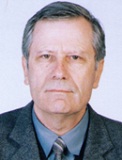
Plenary Lecture
Decomposition of Image Sequences, Represented as Tensors: Algorithms and Applications

Professor Roumen Kountchev
Co-author R. Kountcheva
Faculty of Telecommunications
Department of Radio Communications and Video Technologies
Technical University of Sofia
Bulgaria
E-mail: rkountch@tu-sofia.bg
Abstract: The scientific interest, aimed at the processing of image sequences represented as tensors, was significantly increased in the last years. The comparison of the decompositions, based on the 3D Principal Component Analysis (PCA) and on the multi-linear generalization of the matrix Singular Value Decomposition (SVD) for tensors, shows that the second decomposition is more efficient. In this plenary speech will be presented the main tensor decomposition methods, based on the higher-order extensions of the matrix SVD, such as: the Canonical Decomposition or Parallel Factors Model (CANDECOMP/PARAFAC - CP), where the tensor is a sum of rank-one tensors; the Tucker decomposition, which is a higher-order form of the PCA, the Multilinear SVD (MSVD), etc. One new approach, called Radix-(2×2) Hierarchical SVD (HSVD), which is aimed at the decomposition enhancement, will be also presented. To enhance the decomposition of image sequences (for example, human faces or figures, etc.), represented as tensors, in this speech is proposed the Radix-(2×2) Hierarchical SVD. The basic idea is to represent the tensor decomposition of size N×N×N (for N=2n), by using a hierarchical tree-like structure of N levels, consisting of elementary tensors of size 2x2x2. In the first level each elementary tensor, which builds the tensor of size N×N×N, is decomposed by using the matrix SVD, and the so obtained components are rearranged in accordance with their energy. In the next levels, the edges of the small cube, which represents the elementary tensor, are increased twice. Each enlarged elementary tensor is decomposed once more through SVD, the new components are rearranged again, etc. The maximum number of decomposition levels is n, but depending on the contents of the image sequence, this number could be significantly reduced. The number of branches in the tree-like structure could be decreased by cutting-off these, whose energies are lower than a pre-defined threshold value. Unlike the Multilinear SVD, the new Radix-(2×2) HSVD does not require iterative calculations. In each hierarchical level is repeatedly executed the decomposition of the elementary tensors of size 2x2x2, which permits their parallel calculation. To calculate an elementary tensor, is used matrix SVD of size 2×2, called Radix, whose algebraic representation is of the kind “non-over complete”. In the presentation are also given the block diagrams of the algorithm of the new tensor decomposition for image sequences. The computational complexity of the algorithm is also evaluated: it is approximately 3 times lower than that of the H-Tucker tensor decomposition, but needs larger memory (about 1/3). The method Radix-(2×2) HSVD gives the systems for object recognition better abilities for real-time implementation, and enhances their efficiency. It also opens new possibilities for fast image processing in various application areas, such as: objects search in large video databases, image filtration, segmentation, merging, digital watermarking, extraction of reduced number of features needed for pattern recognition, etc.
Brief Biography of the Speaker: Roumen Kountchev, Ph.D., D. Sc. is a professor at the Faculty of Telecommunications, Department of Radio Communications and Video Technologies at the Technical University of Sofia, Bulgaria. His scientific areas of interest are: digital signal and image processing, image compression, multimedia watermarking, video communications, pattern recognition and neural networks. Prof. Kountchev has 341 papers published in magazines and proceedings of conferences (71 international); 15 books; 45 book chapters; 20 patents (3 international). He had been principle investigator of 38 research projects (6 international). At present he is a member of the Euro Mediterranean Academy of Arts and Sciences (EMAAS), President of Bulgarian Association for Pattern Recognition (member of Intern. Association for Pattern Recognition); Editorial board member of: Intern. Journal of Reasoning-based Intelligent Systems; Intern. Journal Broad Research in Artificial Intelligence and Neuroscience; KES Focus Group on Intelligent Decision Technologies; Egyptian Computer Science Journal; Intern. Journal of Bio-Medical Informatics and e-Health, and Intern. Journal Intelligent Decision Technologies. He has been the plenary speaker at: WSEAS Intern. Conf. on Signal Processing, Istanbul, 2009; WSEAS Intern. Conf. on Signal Processing, Robotics and Automation, University of Cambridge, UK, 2010; WSEAS Intern. Conf. on Signal Processing, Computational Geometry and Artificial Vision, Istanbul, Turkey, 2012; Intern. Workshop on Bioinformatics, Medical Informatics and e-Health, Ain Shams University, Cairo, Egypt, 2013; Intern. Conf. on Information Technology, Al Zayatoonah University, Amman, Jordan, 2015; Colloque SCCIBOV, Université Djillali Liabès de Sidi Bel Abbès, Algérie, 2015.